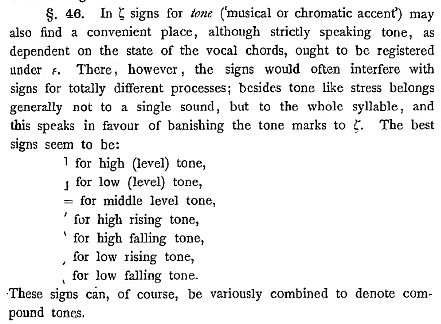Otto Jespersen
Progress of Language

|
His Works Jespersen, with Paul Passy, founded the International Phonetic Association, which created a standard in pronunciation notation. He was an active supporter and developer of artificial international languages such as Esperanto, was also involved in the delegation which created Ido. However, his main achievement in this area was the development of his own artificial language Novial. IPA  Paul Passy During his trips to Europe in 1888, Jespersen met with the French linguist Paul Passy. They had been exchanged letters for several years before this and each was familiar with the other's work. Passy was dissatisfied with the methods of language teaching and in 1886, he founded the Dhi Fonètik Tîcerz’ Asóciécon (Phonetic Teachers' Association) in Paris. One of his concerns was the limitation in language transcription by the letters that were available to typesetters and on typewriters. Jespersen was also interested in this problem and he joined with Passy and German linguist Wilhelm Viëtor in 1889 to expand the association into L’Association Phonétique des Professeurs de Langues Vivantes (Phonetics Association of Teachers of Modern Languages). Jespersen published The Articulations of Speech Sounds to present his own ideas for a system to represent sounds by new composite signs. The organization became L’Association Phonétique Internationale (API) or the International Phonetic Association (IPA) in 1897. It created a chart of sounds and symbols, resulting in an alphabet for a uniform standard of phonetic writing, or phonetic transcription. This alphabet became known as the International Phonetic Alphabet, also using the IPA acronym. It has been refined and updated many times over the years to accommodate the sounds of of the world's languages. The IPA symbols are often used beyond linguistics literature, such as for pronunciation guides in dictionaries and in orthographies created for previously unwritten languages. Novial Jespersen was one of the first philologists to actively support the work being done on establishing an international auxiliary language, referred to as an IAL. In his Progress in Language with Special Reference to English, published in 1894, he expressed his support for the development of an effective IAL: "Primitive language no doubt had a superabundance of irregularities and anomalies, in syntax and word formation not less than in accidence. It was capricious and fanciful, and displayed a luxuriant growth of forms, entangled one with another like the trees in a primeval forest. Human minds of those times disported themselves in these long and intricate words as in the wildest and most wanton play. Primitive speech was certainly not, as is often supposed, distinguished for logical consistency; nor, so far as we can judge, was it simple and facile: it is much more likely to have been extremely clumsy and unwieldy." He rejected Volapük, the constructed language created in 1879 by the Roman Catholic priest Johann Martin Schleyer. He was more interested in the work being done on Esperanto and closely followed the work of Léopold Leau and Louis Couturat and their founding of Délégation pour l'adoption d'une langue auxiliaire internationale (Delegation for the Adoption of an International Auxiliary Language) in 1901. The purpose of this organization was to decide on which international auxiliary language should be chosen for international use. However, his main achievement in this area was the development of his own artificial language, Novial. In May, 1907, Jespersen was elected a member of the committee of the delegation. The committee eventually chose Esperanto, but with certain reforms, which eventually produced a distinct language called Ido. After that, he became president of its Academy and became active in the linguistic discussion in the journal Progreso. Further improvements were made on Ido and there was considerable development on the vocabulary of the language, thanks largely to his experiences as a linguist as well as the criteria which he applied to all proposals for the formation and development of the international auxiliary language. The committee also worked hard to promote Ido for use in the rest of the world, but World War I interrupted these efforts, and, in spite of the initial success, the world remained largely indifferent to adopting it. Not deterred in his enthusiasm, Jespersen published a new language, mainly based on Ido, called Novial In 1928. This was done in his book An International Language (1928) in which he first reviewed the history and theory of international languages then presented the Novial grammar and some texts. The name came from the word Nov ("new") and I.A.L (International Auxiliary Language). In this book, Jespersen also explained the reason for the indifference to adopting Ido, saying "In the first place the time was not yet ripe (in 1907) for a final decision; the principles for an interlanguage had not been thrashed out scientifically, and much of the short time at the committee's disposal had to be spent in clearing away much old rubbish, so that a great many details had to be left for further discussion in Progreso .... but in spite of all - in spite also of the amount of energy squandered away in the quarrels of Esperantists and Idists - the Delegation and the Ido Academy have left their indelible mark on the interlanguage movement, and their influence has been chiefly for the good." He also refuted an objection about the great number of different systems, declaring that these languages may differ in their details but they contain many common features and principles. He stated that "the less arbitrary and the more rational the forms, the more stable they will be." A Novial dictionary for English, French and German was published in 1930 as Novial Lexike. Many reviewers were very positive of Novial, declaring that it was built with common sense and that anyone could learn it. Rank & Nexus  An exerpt of Jespersen’s work, describing some aspects of his proposed reform of phonetic transcription One of Jespersen's most original contributions to grammatical theory was his ideas of rank and nexus, as put forth in his work The Philosophy of Grammar (1924). In his theory of ranks, he proposed that the parts of speech be kept out of syntax, while identifying words as primaries, secondaries, and tertiaries. For example, a noun would be a primary, with a word describing or defining it being a secondary. A third word defining the secondary would be a tertiary. Nexus refer to the core aspect of a sentence, while a dependent nexus would be part of the entire sentence as a subject, object, etc. Another term was junction, which represents one idea expressed by two or more elements, while a nexus combines two ideas. These new theories helped bring together organically related elements which in previous grammatical works were kept separate. Other Works Jespersen was very much concerned with the progress of language, and much of his work is based upon two fundamental principals. The first of these deals with the forms of language. He believed language has an outer form, represented in the phonetical and grammatical aspects, and an inner form, which is the meaning in a wider sense. He believed that sound changes are due to semantic factors, that is, they change because of the meaning words, and not to internal phonetic factors. He was against the German Neogrammarians’ "mechanistic philosophy" which followed the idea that sound laws operate in a systematic nature. They believed in the regularity of sound change, in which a diachronic sound change affects simultaneously all words in which its environment is met, without exception. That is, if within a language, the way a letter or combination of letters is pronounced is altered, all words using that combination immediately have their pronunciations change within the same area the change has been implemented. The second principal Jespersen worked with was an opposition to the notions of decay or degeneration of languages from their purer, primitive forms. He felt instead that languages progress, achieving greater regularity and clarity while becoming more pliable to convey new meanings. He maintained that "language is activity, chiefly social activity undertaken in order to get in touch with other individuals and communicate to them one's thoughts, feelings and will" (Efficiency in linguistic change, 1941). Language is a tool used by people to make themselves mutually understood, thus people will work to shorten the forms and simplify the grammatical system. Jespersen's primary work on linguistic evolution is Language: Its Nature, Development and Origin, published in 1922, and dedicated to Vilhelm Thomsen. It is divided into four books, with Book I presenting the history of linguistic science and Book II talking about the linguistic development of children. Book III, titled The Individual and the World, has chapters on The Foreigner, Pidgins and Congeners, The Woman, and Causes of Change, all of them discussing linguistic development with those groups. Book IV discusses the problem of progress or decay and other aspects of his principles. His last book, Efficiency in Linguistic Change (1941), re-examined these ideas. Jespersen wrote about syntax and the history of language in Growth and Structure of the English (1905). He focused on syntax in his works The Philosophy of Grammar (1924) and Analytic Syntax (1937). In these, Jespersen talked about how syntax must start with meaning and investigate the way particular grammatical notions are expressed, while morphology starts from the form and asks what it stands for. When this happens, categories like negation and tense are seen in a completely new way. Sprogundervisning (How to Teach a Foreign Language), published in 1901, was another major contribution by Jespersen, based upon his prior experience as a secondary school teacher, and it helped prepare future teachers. By means of his numerous works, Jespersen made many valuable contributions to general phonetics and grammar, as well as increasing knowledge of English and Danish and other languages. Throughout his career, he received numerous honours, including three honorary doctor’s degrees from universities abroad, but he never ignored the importance of modern language teaching in schools. His improvements on the teaching of modern languages has influenced educators beyond his own country. He lived in the honorary residence of the Royal Danish Academy of Sciences and Letters in Elsinore from 1934 until his death in 1943. Not only was Jespersen an extremely talented and productive linguist, he was also an excellent communicator, and he is considered one of the most famous of linguists. | ||
|
PARTIAL LIST OF WORKS
| ||
| Otto Jespersen - Progress of Language | ||||||||||||||
| Writer: | Sofia Ozols | |||||||||||||
| Images: | ||||||||||||||
| ||||||||||||||
| Sources: | ||||||||||||||
| ||||||||||||||
All images are Copyright - CC BY-SA (Creative Commons Share Alike) by their respective owners, except for Petey, which is Public Domain (PD) or unless otherwise noted.
comments powered by Disqus



















